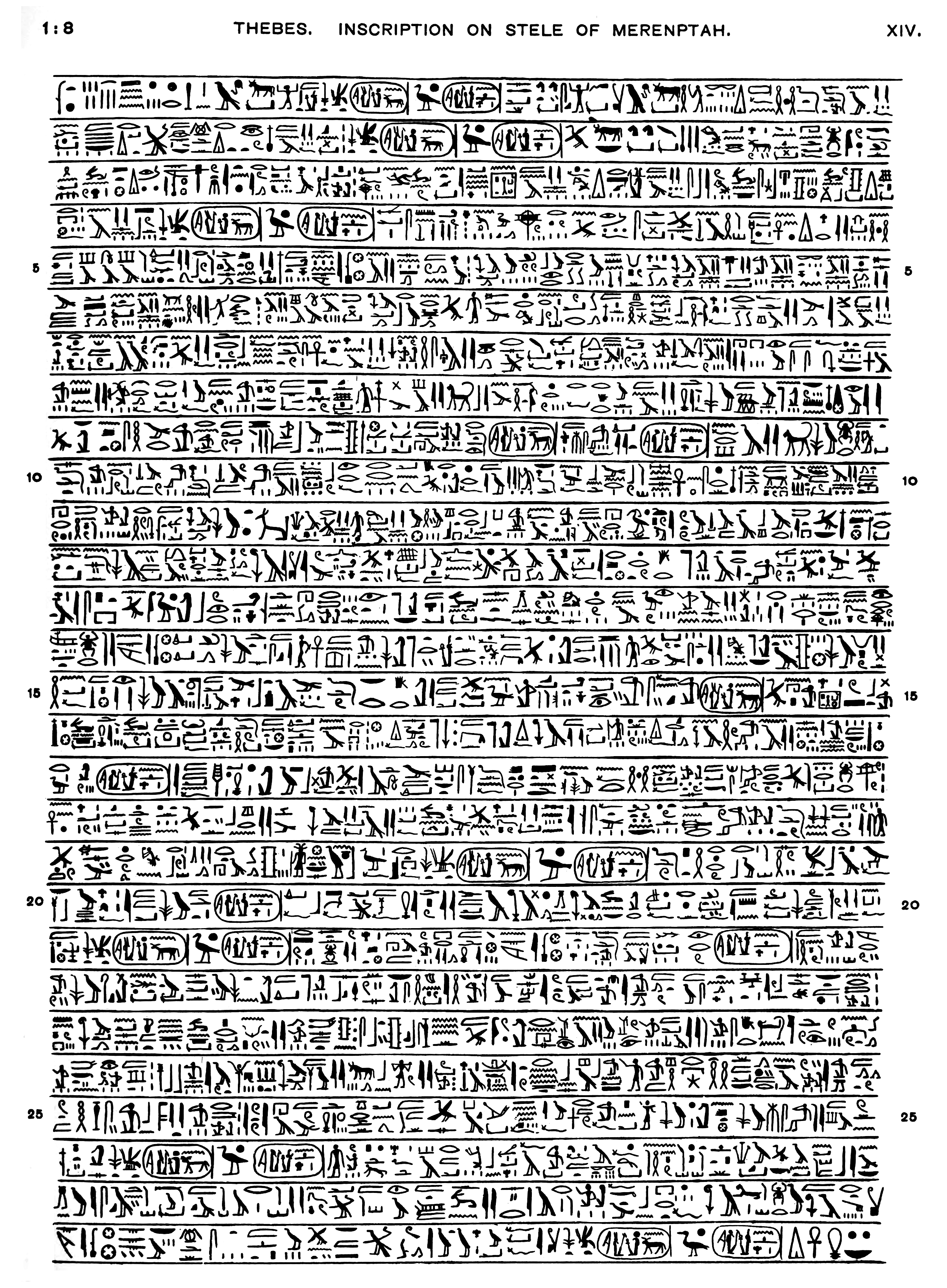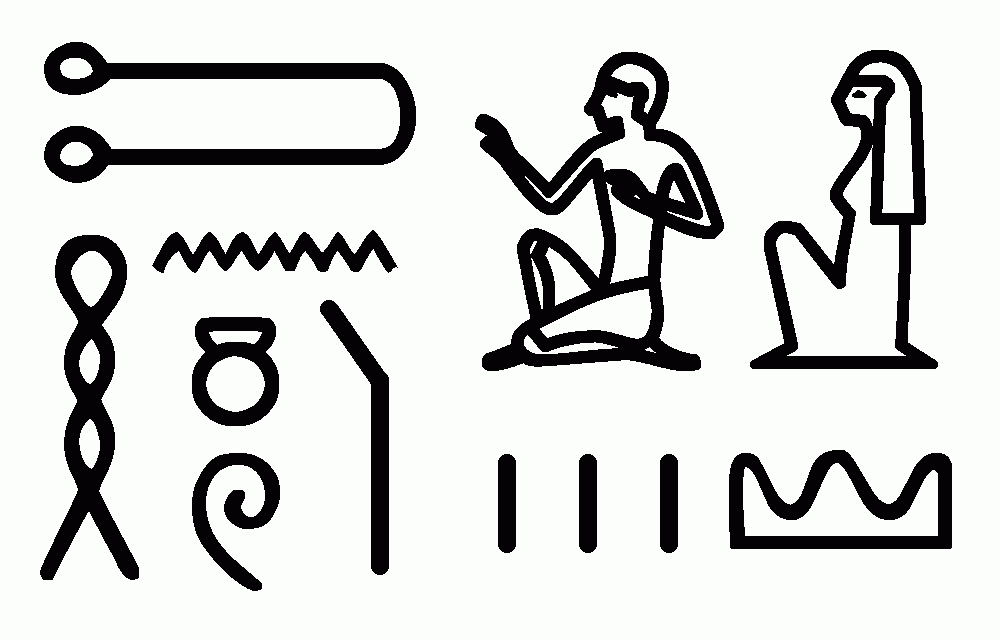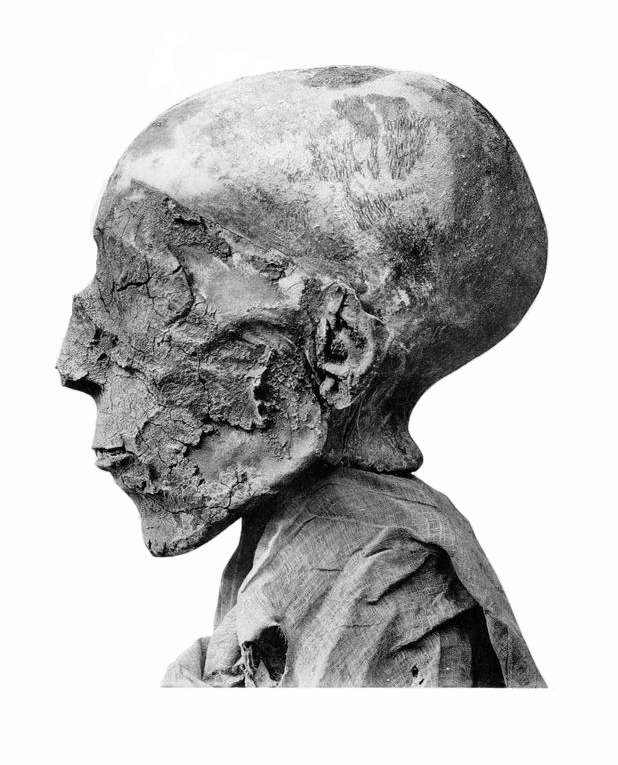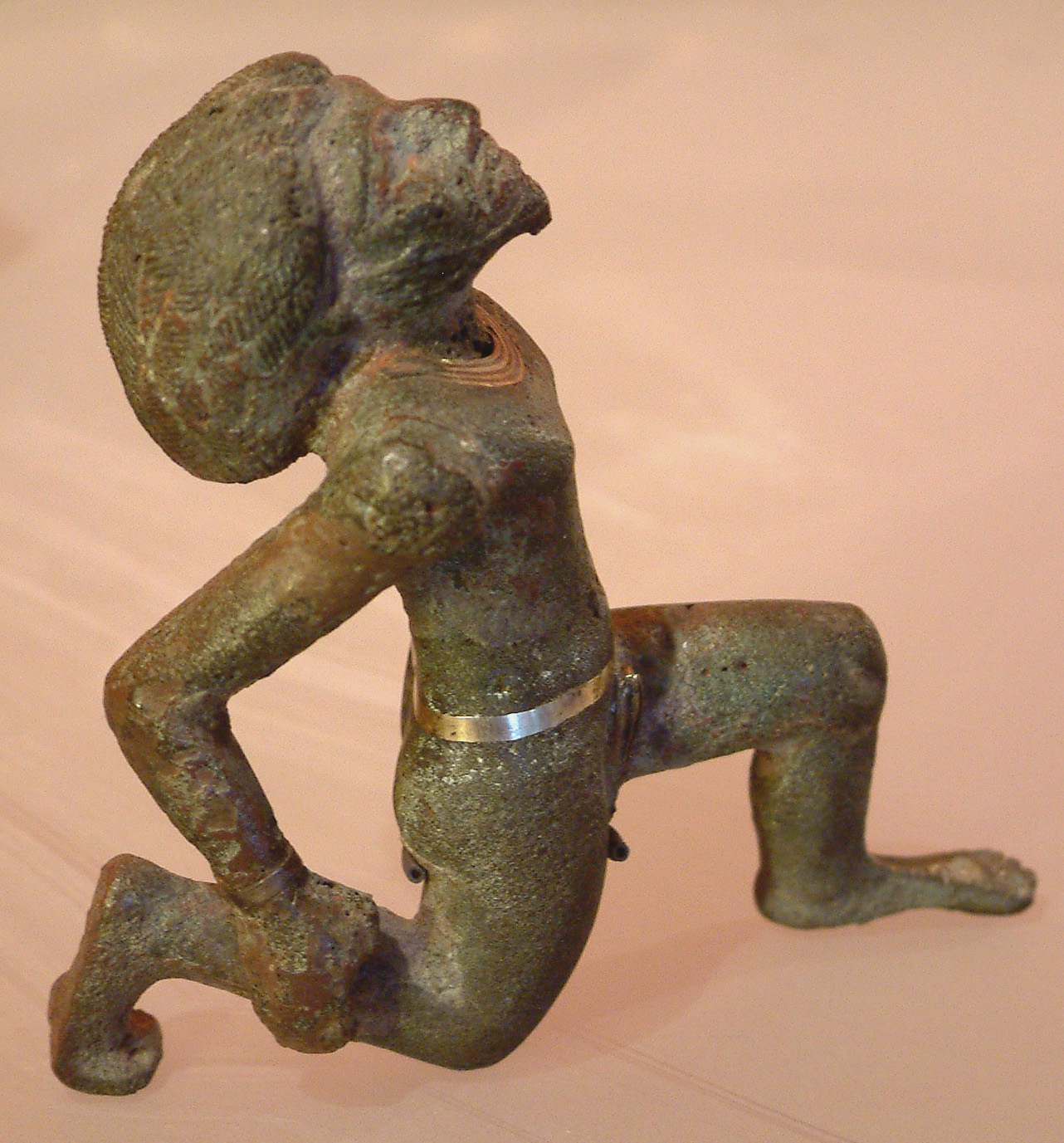|
Merneptah
Merneptah or Merenptah (reigned July or August 1213 BC – May 2, 1203 BC) was the fourth pharaoh of the Nineteenth Dynasty of Ancient Egypt. He ruled Egypt for almost ten years, from late July or early August 1213 BC until his death on May 2, 1203 BC, according to contemporary historical records.Jürgen von Beckerath, ''Chronologie des Pharaonischen Ägypten'', Mainz, (1997), pp.190 He was the thirteenth son of Ramesses II,Gae Callender, ''The Eye Of Horus: A History of Ancient Egypt'', Longman Cheshire (1993), p.263 only coming to power because all his older brothers had died, including his full brother Khaemwaset or Khaemwase. By the time he ascended to the throne, he was probably around seventy years old. He is perhaps best known for his victory stele, featuring the first known mention of the name Israel. His throne name was ''Ba-en-re Mery-netjeru'', which means "The Soul of Ra, Beloved of the Gods". Family Merneptah was likely the fourth child born to Isetnofret I and Ra ... [...More Info...] [...Related Items...] OR: [Wikipedia] [Google] [Baidu] |
Merneptah Stele
The Merneptah Stele, also known as the Israel Stele or the Victory Stele of Merneptah, is an inscription by Merneptah, a pharaoh in ancient Egypt who reigned from 1213–1203 BCE. Discovered by Flinders Petrie at Thebes in 1896, it is now housed at the Egyptian Museum in Cairo. The text is largely an account of Merneptah's victory over the ancient Libyans and their allies, but the last three of the 28 lines deal with a separate campaign in Canaan, then part of Egypt's imperial possessions. It is sometimes referred to as the "Israel Stele" because a majority of scholars translate a set of hieroglyphs in line 27 as "Israel". Alternative translations have been advanced but are not widely accepted. The stele represents the earliest textual reference to Israel and the only reference from ancient Egypt. It is one of four known inscriptions from the Iron Age that date to the time of and mention ancient Israel by name, with the others being the Mesha Stele, the Tel Dan Stele, and t ... [...More Info...] [...Related Items...] OR: [Wikipedia] [Google] [Baidu] |
Merneptah Stele
The Merneptah Stele, also known as the Israel Stele or the Victory Stele of Merneptah, is an inscription by Merneptah, a pharaoh in ancient Egypt who reigned from 1213–1203 BCE. Discovered by Flinders Petrie at Thebes in 1896, it is now housed at the Egyptian Museum in Cairo. The text is largely an account of Merneptah's victory over the ancient Libyans and their allies, but the last three of the 28 lines deal with a separate campaign in Canaan, then part of Egypt's imperial possessions. It is sometimes referred to as the "Israel Stele" because a majority of scholars translate a set of hieroglyphs in line 27 as "Israel". Alternative translations have been advanced but are not widely accepted. The stele represents the earliest textual reference to Israel and the only reference from ancient Egypt. It is one of four known inscriptions from the Iron Age that date to the time of and mention ancient Israel by name, with the others being the Mesha Stele, the Tel Dan Stele, and t ... [...More Info...] [...Related Items...] OR: [Wikipedia] [Google] [Baidu] |
Amenmesse
Amenmesse (also Amenmesses or Amenmose) was the fifth pharaoh of the Nineteenth dynasty of Egypt, Nineteenth Dynasty in Ancient Egypt, possibly the son of Merneptah and Queen Takhat. Others consider him to be one of the innumerable sons of Ramesses II. Very little is known about this pharaoh, who ruled Egypt for only three to four years. Various Egyptologists date his reign between 1202 BC–1199 BC or 1203 BC–1200 BC with others giving an accession date of 1200 BC. Amenmesse means "born of or fashioned by Amun" in Egyptian. Additionally, his Ancient Egyptian royal titulary#Personal name (nomen), nomen can be found with the epithet Heqa-waset, which means "Ruler of Thebes". His royal name was Menmire Setepenre. Usurper It is likely that he was not Merneptah's intended heir. Scholars Kenneth Kitchen and Jürgen von Beckerath have theorized that Amenmesse usurped the throne from Seti-Merneptah, who was Merneptah's son and crown prince and who should have been next in the ... [...More Info...] [...Related Items...] OR: [Wikipedia] [Google] [Baidu] |
Sea Peoples
The Sea Peoples are a hypothesized seafaring confederation that attacked ancient Egypt and other regions in the East Mediterranean prior to and during the Late Bronze Age collapse (1200–900 BCE).. Quote: "First coined in 1881 by the French Egyptologist G. Maspero (1896), the somewhat misleading term 'Sea Peoples' encompasses the ethnonyms Lukka, Sherden, Shekelesh, Teresh, Eqwesh, Denyen, Sikil / Tjekker, Weshesh, and Peleset (Philistines). [Footnote: The modern term 'Sea Peoples' refers to peoples that appear in several New Kingdom Egyptian texts as originating from 'islands' (tables 1–2; Adams and Cohen, this volume; see, e.g., Drews 1993, 57 for a summary). The use of quotation marks in association with the term 'Sea Peoples' in our title is intended to draw attention to the problematic nature of this commonly used term. It is noteworthy that the designation 'of the sea' appears only in relation to the Sherden, Shekelesh and Eqwesh. Subsequently, this term was applied ... [...More Info...] [...Related Items...] OR: [Wikipedia] [Google] [Baidu] |
Israelites
The Israelites (; , , ) were a group of Semitic-speaking tribes in the ancient Near East who, during the Iron Age, inhabited a part of Canaan. The earliest recorded evidence of a people by the name of Israel appears in the Merneptah Stele of ancient Egypt, dated to about 1200 BCE. According to the modern archaeological account, the Israelites and their culture branched out of the Canaanite peoples and their cultures through the development of a distinct monolatristic—and later monotheistic—religion centred on the national god Yahweh.Mark Smith in "The Early History of God: Yahweh and Other Deities of Ancient Israel" states "Despite the long regnant model that the Canaanites and Israelites were people of fundamentally different culture, archaeological data now casts doubt on this view. The material culture of the region exhibits numerous common points between Israelites and Canaanites in the Iron I period (c. 1200–1000 BCE). The record would suggest that the Isra ... [...More Info...] [...Related Items...] OR: [Wikipedia] [Google] [Baidu] |
Seti II
Seti II (or Sethos II) was the fifth pharaoh of the Nineteenth Dynasty of Egypt and reigned from 1203 BC to 1197 BC. His throne name, Userkheperure Setepenre, means "Powerful are the manifestations of Re, the chosen one of Re." He was the son of Merneptah and Isetnofret II and sat on the throne during a period known for dynastic intrigue and short reigns, and his rule was no different. Seti II had to deal with many serious plots, most significantly the accession of a rival king named Amenmesse, possibly a half brother, who seized control over Thebes and Nubia in Upper Egypt during his second to fourth regnal years. Contest for the throne Evidence that Amenmesse was a direct contemporary with Seti II's rule—rather than Seti II's immediate predecessor —includes the fact that Seti II's royal KV15 tomb at Thebes was deliberately vandalised with many of Seti's royal names being carefully erased here during his reign. The erasures were subsequently repaired ... [...More Info...] [...Related Items...] OR: [Wikipedia] [Google] [Baidu] |
Libu
The Libu ( egy, rbw; also transcribed Rebu, Lebu, Lbou, Libou) were an Ancient Libyan tribe of Berber origin, from which the name ''Libya'' derives. Early history Their occupation of Ancient Libya is first attested in Egyptian language texts from the New Kingdom, especially from the Ramesside Period. The earliest occurrence is in a Ramesses II inscription. There were no vowels in the Egyptian script. The name Libu is written as '' rbw'' in Egyptian hieroglyphs. In the Great Karnak Inscription Merneptah describes how hostilities between Egypt and Libya broke out in his regnal year 5 (1208 BCE) and how a coalition of Libu and Sea Peoples led by the chief of the Libu Meryey was defeated. ''Libu'' appears as an ethnic name on ''the Merneptah Stele'', also known as the ''Israel Stele''. Ramesses III defeated the Libyans in the 5th year of his reign, but six years later the Libyans joined the Meshwesh and invaded the western Delta and were defeated again. This name ''Libu'' was ... [...More Info...] [...Related Items...] OR: [Wikipedia] [Google] [Baidu] |
Great Karnak Inscription
The Great Karnak Inscription is an ancient Egyptian hieroglyphic inscription belonging to the 19th Dynasty Pharaoh Merneptah. A long epigraph, it was discovered at Karnak in 1828–1829. According to Wilhelm Max Müller, it is "one of the famous standard texts of Egyptology... nd has been... one of the greatest desiderata of scholars for many years."Muller, p.25 The Great Karnak Inscription is located on the west (inside) of the east wall of the Cachette Court, in the Precinct of Amun-Re of the Karnak temple complex, in modern Luxor. It runs from the fourth pylon of the great sanctuary to the eighth pylon. It was first identified by Champollion, and later partly published by Karl Richard Lepsius. It includes a record of the campaigns of this king against the Sea Peoples The Sea Peoples are a hypothesized seafaring confederation that attacked ancient Egypt and other regions in the East Mediterranean prior to and during the Late Bronze Age collapse (1200–900 BCE).. ... [...More Info...] [...Related Items...] OR: [Wikipedia] [Google] [Baidu] |
Nineteenth Dynasty Of Egypt
The Nineteenth Dynasty of Egypt (notated Dynasty XIX), also known as the Ramessid dynasty, is classified as the second Dynasty of the Ancient Egyptian New Kingdom period, lasting from 1292 BC to 1189 BC. The 19th Dynasty and the 20th Dynasty furthermore together constitute an era known as the ''Ramesside period''. This Dynasty was founded by Vizier Ramesses I, whom Pharaoh Horemheb chose as his successor to the throne. History Background The warrior kings of the early 18th Dynasty had encountered only little resistance from neighbouring kingdoms, allowing them to expand their realm of influence easily, but the international situation had changed radically towards the end of the dynasty. The Hittites had gradually extended their influence into Syria and Canaan to become a major power in international politics, a power that both Seti I and his son Ramesses II would confront in the future. 19th Dynasty Seti and Ramesses II The New Kingdom of Egypt reached the zenith of ... [...More Info...] [...Related Items...] OR: [Wikipedia] [Google] [Baidu] |
Isetnofret
Isetnofret (or Isis-nofret or Isitnofret) ( Ancient Egyptian: "the beautiful Isis") was one of the Great Royal Wives of Pharaoh Ramesses II and was the mother of his successor, Merneptah. She was one of the most prominent of the royal wives, along with Nefertari, and was the chief queen after Nefertari's death (around the 24th year of the pharaoh's reign). Family The parents of Isetnofret are not known. She must have married Ramesses II even before he came to the throne as her eldest children already appear in scenes from the time of Seti I. She had at least three sons and one daughter. Her children include: * Prince Ramesses, Crown Prince from Year 25 to 50 of Ramesses II * Princess-Queen Bintanath, firstborn daughter and later wife of RamessesDodson & Hilton, p.170 * Prince Khaemwaset, High Priest of Ptah. Crown Prince from Year 50 to 55 of Ramesses II * Pharaoh Merneptah, Ramesses' 13th son and ultimate successor (he outlived the first 12 princes) * Pri ... [...More Info...] [...Related Items...] OR: [Wikipedia] [Google] [Baidu] |
Ramesses II
Ramesses II ( egy, wikt:rꜥ-ms-sw, rꜥ-ms-sw ''Rīʿa-məsī-sū'', , meaning "Ra is the one who bore him"; ), commonly known as Ramesses the Great, was the third pharaoh of the Nineteenth Dynasty of Egypt. Along with Thutmose III he is often regarded as the greatest, most celebrated, and most powerful pharaoh of the New Kingdom of Egypt, New Kingdom, itself the most powerful period of Ancient Egypt. The name ''Ramesses'' is pronounced variously . Transliteration of Ancient Egyptian, Other spellings include Rameses and Ramses; in grc-koi, Ῥαμέσσης, Rhaméssēs. He is known as Ozymandias in Greek sources ( grc-koi, Ὀσυμανδύας, translit=Osymandýas), from the first part of Ramesses's regnal name, , "The Maat of Ra is powerful, Chosen of Ra". His successors and later Egyptians called him the "Great Ancestor". At age fourteen, he was appointed prince regent by his father, Seti I. Most Egyptologists today believe he assumed the throne on 31 May 1279 BC, bas ... [...More Info...] [...Related Items...] OR: [Wikipedia] [Google] [Baidu] |
Khaemwaset
Prince Khaemweset (also translated as Khamwese, Khaemwese or Khaemwaset or Setne Khamwas) was the fourth son of Ramesses II and the second son by his queen Isetnofret. His contributions to Egyptian society were remembered for centuries after his death.Aidan Dodson & Dyan Hilton, ''The Complete Royal Families of Ancient Egypt'', Thames & Hudson (2004), p. 170-171 Khaemweset has been described as "the first Egyptologist" due to his efforts in identifying and restoring historic buildings, tombs and temples. Life According to historian Miriam Lichtheim: :Here I should like to stress that Prince Setne Khamwas, the hero of the two tales named for him, was a passionate antiquarian. The historical prince Khamwas, was the fourth son of King Ramses II, had been high priest of Ptah at Memphis and administrator of all the Memphite sanctuaries. In that capacity he had examined decayed tombs, restored the names of their owners, and renewed their funerary cults. Posterity had transmitted his r ... [...More Info...] [...Related Items...] OR: [Wikipedia] [Google] [Baidu] |









